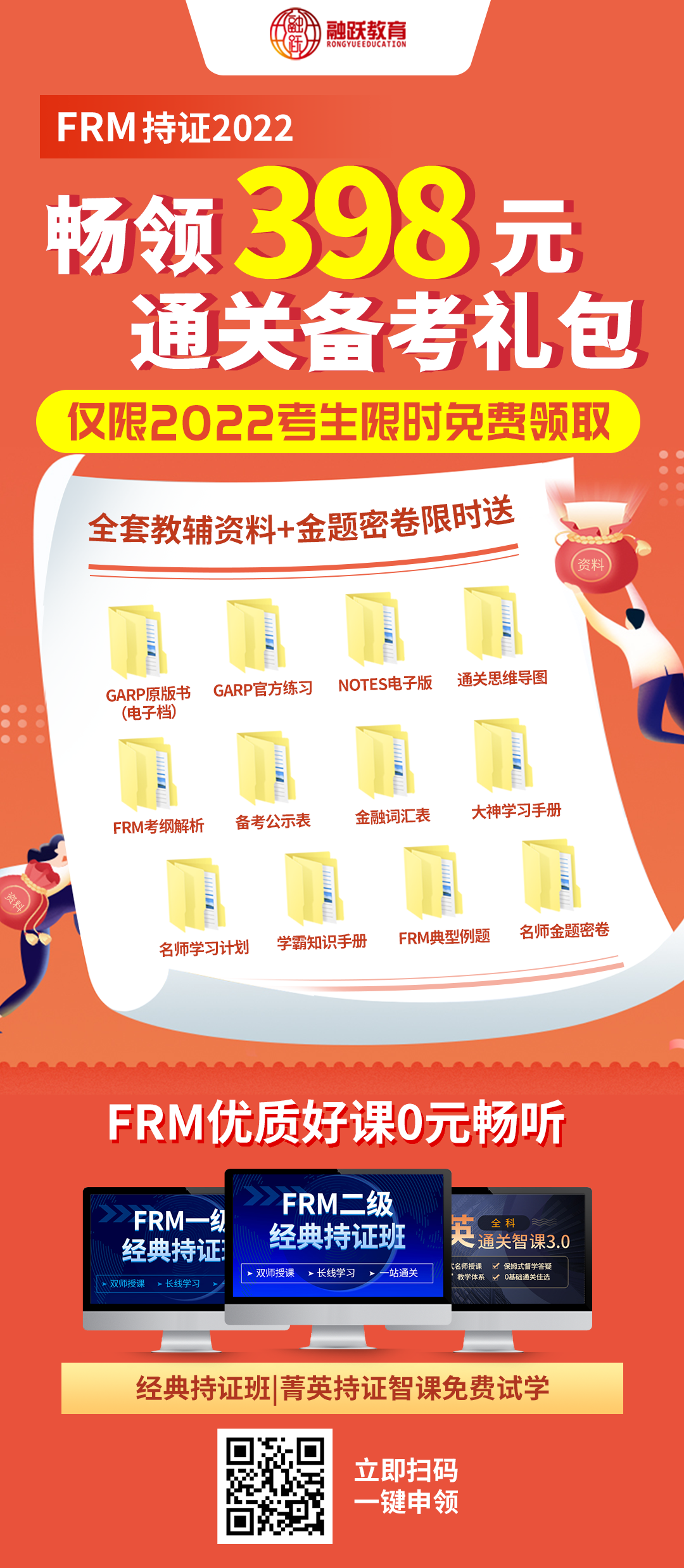备考2022年FRM考试,考生首先需要对考纲的变化有所了解,这样才有利于自己备考。FRM一级考纲在2022年有什么变化?随融跃小编往下看!》》》戳:各科视频讲义+历年真题+21年原版书(PDF版)免·费领取
Financial Market and Products:考纲对比
金融市场与产品这门课占比仍保持在30%,相比于2021年考纲,2022年考纲删掉了6条LOS,增加了2条LOS,其中增加的两条LOS也是对删除LOS的一个补充。
因此,整体来看LOS要求降低了,涉及修改的LOS,多为描述性词汇的调整,主体内容并没有实质性改变。综上,这门课的变动对考生备考影响不大,重点关注新增和删减的LOS即可。
删除的LOS(共6条)
Chapter 5. Exchanges and OTC Markets:
Identify the classes of derivative securities and explain the risk associated with them Chapter 10. Pricing Financial Forwards and Futures:
Differentiate between investment and consumption assets.
Calculate a forward foreign exchange rate using the interest rate parity relationship
Chapter 11. Commodity Forwards and Futures:
Compare the lease rate with the convenience yield.
Chapter 18. Mortgages and Mortgage-Backed Securities:
Describe the mortgage prepayment option and the factors that influence prepayments
Chapter 19. Interest Rate Futures :
Describe the mortgage prepayment option and the factors that influence prepayments
增加的LOS(共2条)
Chapter 5. Exchanges and OTC Markets:
Describe process of buying stock on margin without using CCP and calculate margin requirements
Chapter 10. Pricing Financial Forwards and Futures:
Define and describe financial assets
修改的LOS:(共11条)
Chapter 3. Fund Management:
Calculate the net asset value (NAV) of an open-end mutual fund. (2021)
Explain the concept of net asset value (NAV) of an open-end mutual fund and how it relates to share price. (2022)
Chapter 4. Introduction to Derivatives:
Calculate an arbitrage payoff and describe how arbitrage opportunities are temporary. (2021)
Describe arbitrageurs' strategy and calculate an arbitrage payoff. (2022)
Chapter 5. Exchanges and OTC Markets:
Describe netting and describe a netting process(2021)
Define netting and describe a netting process. (2022)
Chapter 6. Central Clearing:
Compare and contrast bilateral markets to the use of novation and netting(2021)
Compare netting in bilateral markets vs centrally cleared(2022)
Chapter 7. Futures Markets:
Evaluate the impact of different trading order types. (2021)
Describe and compare different trading order types. (2022)
Chapter 8. Using Futures for Hedging:
Define the basis and explain the various sources of basis risk and explain how basis risks arise when hedging with futures. (2021)
Define and calculate the basis, discuss various sources of basis risk, and explain how basis risks arise when hedging with futures. (2022)
Define cross hedging and compute and interpret the minimum variance hedge ratio and hedge effectiveness. (2021)
Define cross hedging and compute and interpret hedge ratio and hedge effectiveness(2022)
Chapter 11. Commodity Forwards and Futures:
Explain the relationship between current futures prices and expected future spot prices, including the impact of systematic and nonsystematic risk(2021)
Explain the impact of systematic and nonsystematic risk on current futures prices and expected future spot prices(2022)
Chapter 12. Options Markets:
Describe the various types, uses, and typical underlying assets of options. (2021)
Describe the various types and uses of options, define moneyness(2022)
Chapter 18. Mortgages and Mortgage-Backed Securities:
Explain prepayment modeling and its four components: refinancing, turnover, defaults and curtailments(2021)
Describe the mortgage prepayment option and factors that affect it, explain prepayment modeling and its four components: refinancing, turnover, defaults, and curtailments(2022)
Chapter 16. Option Sensitivity Measures: The “Greeks”:
Describe how portfolio insurance can be created through option instruments and stock index futures. (2021)
Describe how to implement portfolio insurance and how this strategy compares with delta hedging. (2022)
Valuation and Risk Models:考试比重
该学科在一级考试中的占比仍然为30%,依然是一级考试的重点学科。内容上,有部分删减和调整。
考点对比:
这门课整体删减了11条考点,新增了3点考点,从LOS来看对考生的考察要求降低了。两条修改的内容,仅仅是对原有内容的补充,主体内容没有变化。主要涉及的考点并没有发生过多变化,重点章节无太大改变。
新增的LOS(共3条)
Chapter 4. External and Internal Credit Ratings
Define conditional and unconditional default probabilities and explain the distinction between the two.
Chapter 6. Measuring Credit Risk
Describe the degree of dependence typically observed among the loan defaults in a bank’s loan portfolio, and explain the implications for the portfolio’s default rate.
Chapter 8. Stress Testing
Describe the role of policies and procedures, validation, and independent review in stress testing governance.
删减的LOS(共11条)
Chapter 1. Measures of Financial Risk
Explain the limitations of the mean-variance framework with respect to assumptions about return distributions.
Chapter 3. Measuring and Monitoring Volatility
Calculate conditional volatility using parametric and non-parametric approaches.
Calculate conditional volatility with and without mean reversion.
Describe the impact of mean reversion on long horizon conditional volatility estimation.
Chapter 4. External and Internal Credit Ratings
Describe the impact of time horizon, economic cycle, industry and geography on external ratings.
Chapter 5. Country Risk: Determinants, Measures, and Implications
Identify sources of country risk.
Chapter 6. Measuring Credit Risk
Evaluate a bank’s economic capital relative to its level of credit risk.
Identify and describe important factors used to calculate economic capital for credit risk: probability of default, exposure and loss rate.
Chapter 8. Stress Testing
Identify the advantages and disadvantages of stressed risk metrics.
Identify elements of clear and comprehensive policies, procedures, and documentations for stress testing.
Identify areas of validation and independent review for stress tests that require attention from a governance perspective.
替换的LOS
Chapter 3. Measuring and Monitoring Volatility
Apply the exponentially weighted moving average (EWMA) approach and the GARCH (1,1) model to estimate volatility, and describe alternative approaches to weighting historical return data. (2022)
Apply the exponentially weighted moving average (EWMA) approach and the GARCH(1,1) model to estimate volatility. (2021)
Chapter 8. Stress Testing
Describe stressed VaR and stressed ES, including their advantages and disadvantages, and compare the process of determining stressed VaR and ES to that of traditional VaR and ES. (2022)
Describe stressed VaR and stressed ES and compare the process of determining stressed VaR and ES to that of traditional VaR and ES. (2021)
希望以上的内容对你有所帮助!如果您想了解更多FRM考试相关问题,添加融跃FRM老师微信(15378732641),给您专业的指导帮助!
- 报考条件
- 报名时间
- 报名费用
- 考试科目
- 考试时间
-
GARP对于FRM报考条件的规定:
What qualifications do I need to register for the FRM Program?
There are no educational or professional prerequisites needed toregister.
翻译为:报名FRM考试没有任何学历或专业的先决条件。
可以理解为,报名FRM考试没有任何的学历和专业的要求,只要是你想考,都可以报名的。查看完整内容 -
2024年5月FRM考试报名时间为:
早鸟价报名阶段:2023年12月1日-2024年1月31日。
标准价报名阶段:2024年2月1日-2024年3月31日。2024年8月FRM考试报名时间为:
早鸟价报名阶段:2024年3月1日-2024年4月30日。
标准价报名阶段:2024年5月1日-2024年6月30日。2024年11月FRM考试报名时间为:
早鸟价报名时间:2024年5月1日-2024年7月31日。
标准价报名时间:2024年8月1日-2024年9月30日。查看完整内容 -
2023年GARP协会对FRM的各级考试报名的费用作出了修改:将原先早报阶段考试费从$550上涨至$600,标准阶段考试费从$750上涨至$800。费用分为:
注册费:$ 400 USD;
考试费:$ 600 USD(第一阶段)or $ 800 USD(第二阶段);
场地费:$ 40 USD(大陆考生每次参加FRM考试都需缴纳场地费);
数据费:$ 10 USD(只收取一次);
首次注册的考生费用为(注册费 + 考试费 + 场地费 + 数据费)= $1050 or $1250 USD。
非首次注册的考生费用为(考试费 + 场地费) = $640 or $840 USD。查看完整内容 -
FRM考试共两级,FRM一级四门科目,FRM二级六门科目;具体科目及占比如下:
FRM一级(共四门科目)
1、Foundations of Risk Management风险管理基础(大约占20%)
2、Quantitative Analysis数量分析(大约占20%)
3、Valuation and Risk Models估值与风险建模(大约占30%)
4、Financial Markets and Products金融市场与金融产品(大约占30%)
FRM二级(共六门科目)
1、Market Risk Measurement and Management市场风险管理与测量(大约占20%)
2、Credit Risk Measurement and Management信用风险管理与测量(大约占20%)
3、Operational and Integrated Risk Management操作及综合风险管理(大约占20%)
4、Liquidity and Treasury Risk Measurement and Management 流动性风险管理(大约占15%)
5、Risk Management and Investment Management投资风险管理(大约占15%)
6、Current Issues in Financial Markets金融市场前沿话题(大约占10%)查看完整内容 -
2024年FRM考试时间安排如下:
FRM一级考试:
2024年5月4日-5月17日;
2024年8月3日(周六)上午;
2024年11月2日-11月15日。FRM二级考试:
2024年5月18日-5月24日;
2024年8月3月(周六)下午;
2024年11月16日-11月22日。查看完整内容
-
中文名
金融风险管理师
-
持证人数
25000(中国)
-
外文名
FRM(Financial Risk Manager)
-
考试等级
FRM考试共分为两级考试
-
考试时间
5月、8月、11月
-
报名时间
5月考试(12月1日-3月31日)
8月考试(3月1日-6月30日)
11月考试(5月1日-9月30日)








